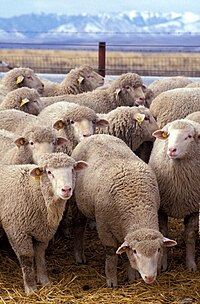
Photo from wikipedia
Abstract Land‐use and land‐cover change associated with agriculture is one of the main drivers of biodiversity loss. In heavily modified agricultural landscapes, grazing lands may be the only areas that… Click to show full abstract
Abstract Land‐use and land‐cover change associated with agriculture is one of the main drivers of biodiversity loss. In heavily modified agricultural landscapes, grazing lands may be the only areas that can provide essential resources for native grassland species. Management decisions, such as choice of livestock species, affect the extent to which grazing lands provide suitable habitat for native species such as pollinators. Our study compared how sheep versus cattle herbivory affected floral resources and butterfly abundance across low‐diversity, former Conservation Reserve Program (CRP) pastures managed with patch‐burn grazing. Across all years (2017–2019), flowering species richness and abundance were significantly higher in cattle pastures than sheep pastures. On average, we recorded 6.9 flowering species/transect in cattle pastures and 3.8 flowering species/transect in sheep pastures. The average floral abundance per transect was 1278 stems/transect in cattle pastures and 116 stems/transect in pastures grazed by sheep. Similarly, we observed higher butterfly species richness, diversity, and abundance in cattle than in sheep pastures. In cattle pastures, we observed an average of 75 butterflies and 6.75 species per transect, compared with an average of 52 butterflies and 3.37 species per transect in sheep pastures. However, the butterfly community composition did not significantly differ between grazing treatments likely because agricultural‐tolerant, habitat generalists comprised the majority of the butterfly community. Five generalist butterflies comprised 92.3% of observations; Colias philodice was the most abundant (61% of observations). Speyeria idalia and Danaus plexippus, two butterflies of conservation concern, comprised less than 0.5% of butterfly observations. Our results, which are among the first attempt quantifying butterfly use of post‐CRP fields grazed by livestock, show that increased precipitation and cattle grazing promoted higher forb abundance and richness. However, additional interventions may be needed to enhance floral resources to sustain and improve pollinator diversity in these landscapes.
Journal Title: Ecology and Evolution
Year Published: 2022
Link to full text (if available)
Share on Social Media: Sign Up to like & get
recommendations!